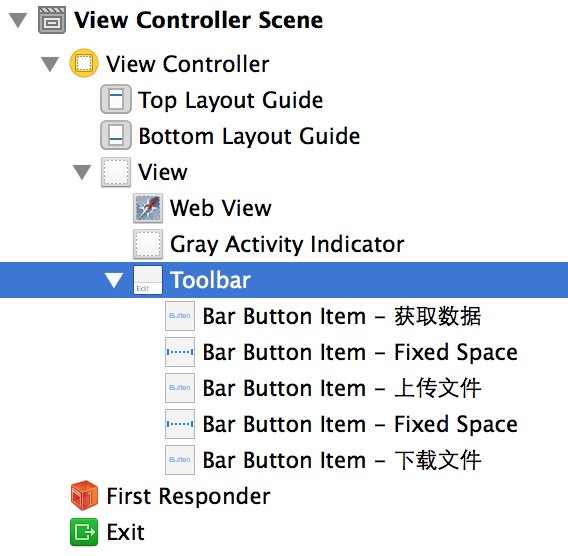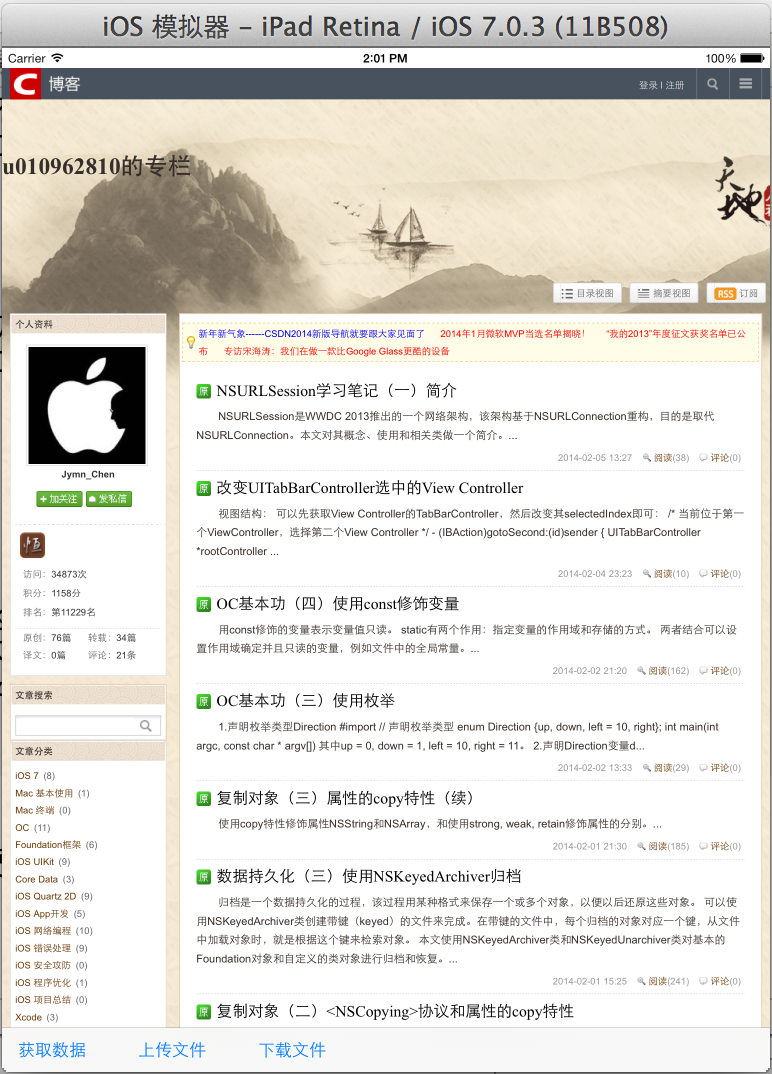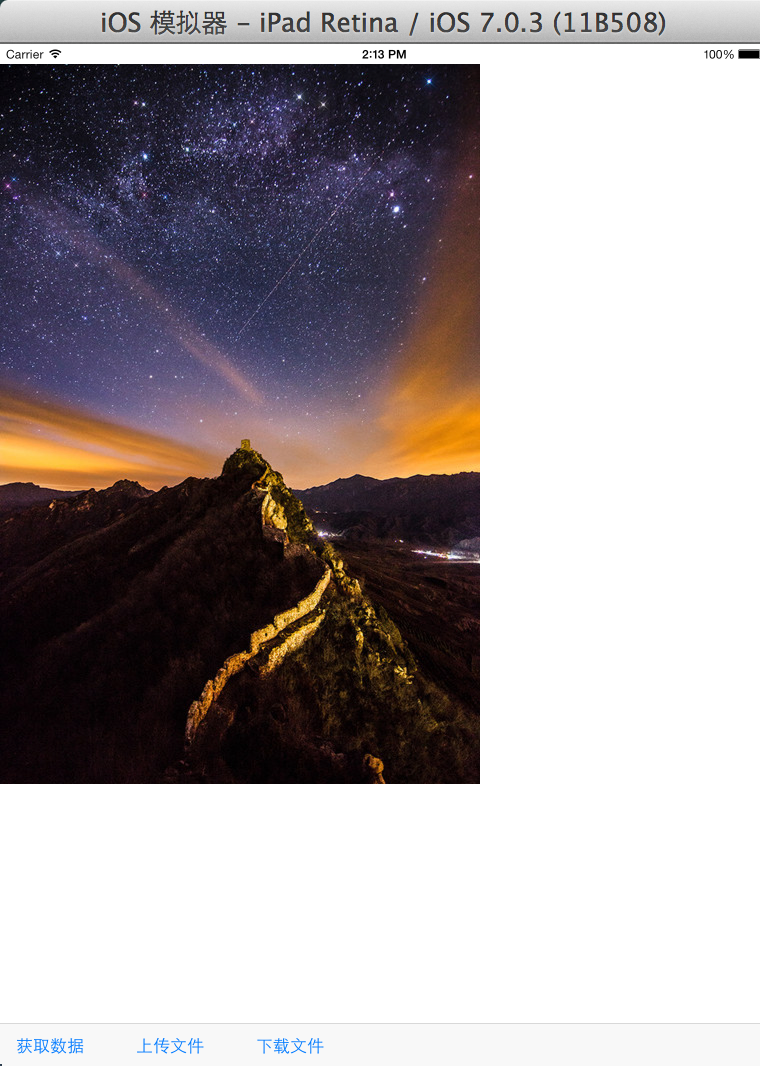Session Task分为三种Data Task,Upload Task,Download Task。毫无疑问,Session Task是整个NSURLSession架构的核心目标。
下面写了一个简单的Demo来初步使用下三种任务对象。这里使用的是convenience methods,并没有定制session和使用协议,都是采用completionHandler作为回调动作。
故事板内容为:
第一种Data Task用于加载数据,使用全局的shared session和dataTaskWithRequest:completionHandler:方法创建。代码如下:
/* 使用NSURLSessionDataTask加载网页数据 */
- (IBAction)loadData:(id)sender {
// 开始加载数据,让spinner转起来
[self.spinner startAnimating];
// 创建Data Task,用于打开我的csdn blog主页
NSURL *url = [NSURL URLWithString:@"http://blog.csdn.net/u010962810"];
NSURLRequest *request = [NSURLRequest requestWithURL:url];
NSURLSession *session = [NSURLSession sharedSession];
NSURLSessionDataTask *dataTask = [session dataTaskWithRequest:request
completionHandler:
^(NSData *data, NSURLResponse *response, NSError *error) {
// 输出返回的状态码,请求成功的话为200
[self showResponseCode:response];
// 在webView中加载数据
[self.webView loadData:data
MIMEType:@"text/html"
textEncodingName:@"utf-8"
baseURL:nil];
// 加载数据完毕,停止spinner
[self.spinner stopAnimating];
}];
// 使用resume方法启动任务
[dataTask resume];
}
/* 输出http响应的状态码 */
- (void)showResponseCode:(NSURLResponse *)response {
NSHTTPURLResponse* httpResponse = (NSHTTPURLResponse*)response;
NSInteger responseStatusCode = [httpResponse statusCode];
NSLog(@"%d", responseStatusCode);
}completionHandler指定任务完成后的动作。注意一定要使用resume方法启动任务。(Upload Task和Download Task同理)
运行结果:
第二种Upload Task用于完成上传文件任务,使用方法类似:
/* 使用NSURLSessionUploadTask上传文件 */
- (IBAction)uploadFile:(id)sender {
// NSURL *URL = [NSURL URLWithString:@"http://example.com/upload"];
// NSURLRequest *request = [NSURLRequest requestWithURL:URL];
// NSData *data = ...;
//
// NSURLSession *session = [NSURLSession sharedSession];
// NSURLSessionUploadTask *uploadTask = [session uploadTaskWithRequest:request
// fromData:data
// completionHandler:
// ^(NSData *data, NSURLResponse *response, NSError *error) {
// // ...
// }];
//
// [uploadTask resume];
}第三种Download Task用于完成下载文件的任务,使用全局的shared session和downloadTaskWithRequest:completionHandler:方法创建。
注意:在下载任务完成后,下载的文件位于tmp目录下,由代码块中的location指定(不妨输出看看),我们必须要在completion handler中将文件放到持久化的目录下保存。代码如下:
/* 使用NSURLSessionDownloadTask下载文件 */
- (IBAction)downloadFile:(id)sender {
[self.spinner startAnimating];
NSURL *URL = [NSURL URLWithString:@"http://b.hiphotos.baidu.com/image/w%3D2048/sign=6be5fc5f718da9774e2f812b8469f919/8b13632762d0f703b0faaab00afa513d2697c515.jpg"];
NSURLRequest *request = [NSURLRequest requestWithURL:URL];
NSURLSession *session = [NSURLSession sharedSession];
NSURLSessionDownloadTask *downloadTask = [session downloadTaskWithRequest:request
completionHandler:
^(NSURL *location, NSURLResponse *response, NSError *error) {
[self showResponseCode:response];
// 输出下载文件原来的存放目录
NSLog(@"%@", location);
// 设置文件的存放目标路径
NSString *documentsPath = [self getDocumentsPath];
NSURL *documentsDirectoryURL = [NSURL fileURLWithPath:documentsPath];
NSURL *fileURL = [documentsDirectoryURL URLByAppendingPathComponent:[[response URL] lastPathComponent]];
// 如果该路径下文件已经存在,就要先将其移除,在移动文件
NSFileManager *fileManager = [NSFileManager defaultManager];
if ([fileManager fileExistsAtPath:[fileURL path] isDirectory:NULL]) {
[fileManager removeItemAtURL:fileURL error:NULL];
}
[fileManager moveItemAtURL:location toURL:fileURL error:NULL];
// 在webView中加载图片文件
NSURLRequest *showImage_request = [NSURLRequest requestWithURL:fileURL];
[self.webView loadRequest:showImage_request];
[self.spinner stopAnimating];
}];
[downloadTask resume];
}
/* 获取Documents文件夹的路径 */
- (NSString *)getDocumentsPath {
NSArray *documents = NSSearchPathForDirectoriesInDomains(NSDocumentDirectory, NSUserDomainMask, YES);
NSString *documentsPath = documents[0];
return documentsPath;
}运行结果:
这个Demo中没有为NSURLSession指定session的delegate,所以没有使用委托中的方法,功能比较有限,而且也没有自行定制session的配置,所以只能执行简单的任务,但是对于加载数据,下载一张图片等任务已经可以应付自如。对于创建后台下载任务,支持断点续传的下载任务等将在下一篇文章中分析介绍。



























 152
152

 被折叠的 条评论
为什么被折叠?
被折叠的 条评论
为什么被折叠?








